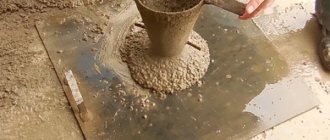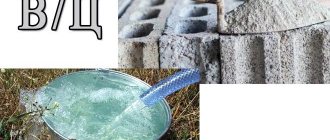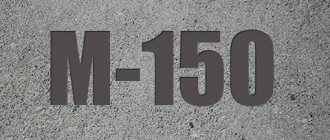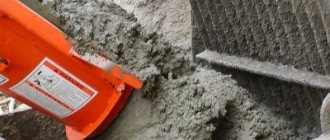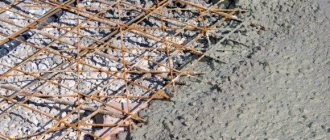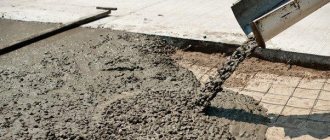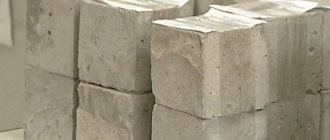The method of vacuuming concrete is successfully used in the construction of floors in industrial and public buildings. The work consists of constructing a monolithic concrete structure using special vacuum equipment that dehydrates the solution. This is a fairly progressive method that works to improve the quality of floors, their wear resistance, and strength. The construction of the structure requires a minimum of labor costs.
General characteristics
Vacuuming is a technological technique that helps extract some of the water from poured and compacted concrete. This helps to use solutions with high mobility without negative consequences. We learned a long time ago how to correct the hardness of a mixture by vacuuming. In the USSR, the technology worked back in the 40s during the construction of hydraulic structures.
Work can be carried out on unformed and formworked surfaces . There is limited practice of internal vacuum processing using dip tubes, but the effective application of this method is still being developed.
The coating, prepared using vacuum technology, is monolithic, seamless, dust-free
Floors made using the vacuum method are distinguished by their high density, which allows them to withstand severe mechanical loads.
Here it is advisable to consider the influence of water on the quality of concreting and the characteristics of concrete. The ratio of cement and water determines the most important characteristic of the mixture - hardness. The stiffer the concrete, the less water it contains and the less shrinkage . Powerful vibrators and pavers cannot be used on the construction site, so the mixture is often mixed with a significant water content.
But such a w/c ratio leads to problems:
- long hardening times - 28 days;
- unequal strength across layers - in the lower ones it is higher than in the upper ones by about 10%;
- formation of microcracks;
- at high temperatures, the maturation of concrete is disrupted, that is, the surface requires protection;
- concrete acquires a porous structure, especially in the surface layers. This reduces water resistance, frost resistance, resistance to vibration, and dynamic loads.
To carry out the work, the use of a vacuum complex will be required. A set of equipment helps to lay floors up to 20 cm thick . If operating conditions are such that the coating must be highly durable, use concrete with strength class B22.5, B15.
The basics of the technology are as follows:
- Excess mixing water is removed from the layer of laid concrete. In general, about 30% of the liquid is removed from the screed. This affects the compaction of the solution and the rapid increase in strength. Using this technology, it is possible to use concrete with plasticizing additives, which improves workability;
- the need for expansion joints is sharply reduced. Without cutting, you can leave 250-300 sq.m. surfaces. This is due to a significant reduction in shrinkage deformations;
- during the work, it is possible to increase the water resistance of the structure by coating the surface with special polymer compounds;
- Vacuuming in combination with special coatings ensures high strength at an early stage of ripening. This is especially true in production, since it is possible to install equipment directly during construction work.
All work is carried out based on the standards SNiP 3.03.01-87 “Load-bearing and enclosing structures” and SNiP 3.04.01-87 “Insulating and finishing coatings”.
The process of pouring a monolithic evacuated floor consists of the following stages:
- preparation of the base and installation of guides;
- delivery of concrete to the base, distribution of the mixture;
- compaction with surface vibrators;
- surface treatment with vacuum equipment;
- grouting with concrete finishing machines;
- grinding with concrete finishing machines.
The evacuated floor becomes resistant to chemicals and is less susceptible to cracking
Scope of application
is advisable to use the technique on areas of at least 700-1000 sq.m. These are the floors of industrial workshops, warehouses, garages, airfields, port facilities, and parking lots. Vacuumed concrete serves as a leveling and protective coating on bridge structures, as a floor in monolithic housing construction, and acts as a concrete preparation for various types of finishing coatings.
Definition
Vacuuming concrete is the removal of excess water from a freshly laid concrete solution using air rarefaction. The use of vacuuming is allowed only for concrete based on silicate and slag silicate cements.
The liquid in the concrete mixture is important, but it should be only 20% of the volume of cement. Excess water will evaporate and may cause cracks or pores, which will reduce the density, water resistance, and thermal insulation properties of the building material. The meaning of the treatment is to compact the concrete mixture by sucking out excess water and air from it, creating an internal vacuum.
Return to contents
Preliminary preparation
When starting to implement the technology, the scope of work should be determined.
The main operations are as follows:
- delivery and storage of materials and equipment, serviceability check;
- supply of water, electricity;
- preparing the base;
- cleaning the surface from construction debris;
- implementation of markings for grips, marking horizon marks for guides.
Primary preparation of the base consists of cleaning the surface. Oil, grease stains, and solution splashes must be removed. Next, you should check the evenness and slope, for which you use a level and a two-meter strip. Deviations should not exceed 2 mm horizontally.
Marking and installation of guide rails
The markings are applied to a previously cleaned base. The work is carried out based on the dimensions of the floor and the length of the vibrating screed. The length of one grip is calculated so as to ensure continuity of pouring during one work shift . It is better to lay the maximum possible width, but not more than 6 meters. Use a tape measure and a chalk cord to mark the placement of the guides.
Rail forms are used as guides. This is a fairly simple system, which consists of a triangular perforated profile, adjusting screws, metal pads, and a polyethylene insert. The last element works for easy sliding of the vibrating screed. The required height can be adjusted without any hassle using screws . The pads are mounted on the base of the guides and act as a tightening stiffening element. This will prevent the rail from bending.
Fill a bucket with the prepared solution. Moving along the markings, portions of mortar are laid in 1.5 m increments at the locations where the guides are installed. The slats (rail-forms) are lowered onto the beacons. The system is laid end-to-end throughout the concreting area. Instead of mortar, you can use special supports, which are included in any professional kit .
A level is placed on the staff, in accordance with the measurements, the position of the guide is adjusted with light blows until the design mark is reached. The correct installation is verified both in height and in plane. Arranged grips should be numbered. This makes it easier to maintain the sequence and order of operations.
The finished guides must be fixed to the base so that they cannot move due to the pressure of the solution . The material used should not sag if wooden planks or steel pipes are used as the material.
Concrete is poured in strips, one after another, according to the numbering
Formwork
The need to install formwork depends on the type of structure and the thickness of the layer being installed. The system is installed together with the guides, strictly according to the marks and heights, with careful adjustment of the joints. The slats and formwork can be fixed with anchors or other supporting devices.
When is vacuuming required?
According to standards, the concrete mixture should contain no more than 20% liquid. If there is too much water, it will begin to evaporate, causing cracks to appear in the mass, which means the important characteristics of concrete (thermal insulation, water resistance, density) will decrease. This is a serious violation and significantly reduces the life of the structure or concrete structure.
It would be logical to immediately add less water to the batch, but in this case the workability of the solution will noticeably deteriorate. Therefore, during pouring, it should contain about 35-55% moisture. In this case, the mixture will not set immediately, which means there is no risk of delamination. That is why the more “watery” concrete is poured first, and then excess moisture is removed from it, that is, it is compacted.
On the one hand, you can vibrate for this. But in this case, only part of the excess moisture will be brought to the surface. When vacuuming, excess water is extracted more efficiently and in the required volume. This is a technological method that can increase the moisture content to 10-25%. Thanks to this, it becomes possible to use a mixture with a mobility of up to 10 cm.
However, this method of compaction is not always required. Compaction is mainly carried out when:
- road laying;
- pouring a concrete floor or underlying layer;
- formation of open concrete platforms;
- installation of power lines;
- construction of bridge supports;
- production of floor slabs;
- construction of foundations, side walls, vaults.
Vacuuming saves cement and significantly speeds up stripping and construction work in general. The concrete becomes more durable and its characteristics are improved, including frost resistance. Depending on the type of structure being built, side or top vacuuming can be performed.
Construction of vacuum-sealed monolithic concrete floors
During the work, it is extremely important to maintain a rhythmic supply of concrete. If a ready-made solution is purchased, it is transported to the site by concrete mixer trucks. The mixture is supplied to the pouring site by concrete pumps, conveyors, and cranes . Inside enclosed spaces, material is transported by carts.
With automatic supply of concrete, the worker fills the pouring map (strip) with the mixture with a hose, gradually moving backwards. Concrete is distributed over the entire width of the strip, every other one.
Requirements for concrete mixture
The composition of the solution must meet the requirements of GOST 7473-94. If the material is purchased in finished form, this is negotiated with the manufacturer, incl. aggregate size, workability, water resistance, etc.
Other requirements are:
- Portland cement M400 is used. For concrete class B15, the minimum consumption is 300 kg/cub.m (GOST 10178-85);
- fine aggregate - sand, should not contain more than 7% dust particles (0.14 mm) and more than 20% fine particles (0.31 mm) (GOST 8736-93);
- if gravel is used as a coarse aggregate, the sand content should be 32-45%, if crushed stone - 40-60%;
- in concrete for evacuation, the sand content is 150-200 kg more compared to traditional mortar;
- coarse aggregate can be crushed stone, gravel (GOST 8267-93). The maximum fineness should not exceed 0.6 of the thickness of the screed or up to 15 mm - for a layer 20-50 mm thick and 20 mm - for 200 mm;
- optimal w/c ratio – 0.6;
- the mobility of the mixture according to the technology is 8-10 cm.
The approximate formulation of solutions for vacuum processing is shown in the table
| Component | Unit. | Consumption per cubic meter | ||
| Concrete class | ||||
| B15 | IN 20 | B22.5 | ||
| Cement M400 | kg | 300 | 333 | 355 |
| Crushed stone 20 mm | kg | 1270 | 1265 | 1260 |
| Sand | kg | 655 | 643 | 620 |
| Water | l | 200 | 200 | 200 |
Leveling and compaction
Primary (rough) leveling of the laid mixture is carried out with combs and shovels. It should lie evenly across the entire width of the strip. If for some reason the supply of concrete has stopped, a board is installed across the gripper, which will limit the working seam . Subsequent leveling and compaction is carried out using a vibrating screed.
When the layer thickness is more than 20 cm, deep vibrators are used for compaction
Sealing with a rack is carried out as follows:
- when the distribution of concrete along the strip is completed, they are quickly passed with a vibrating lath;
- after this, the bulk of the solution is leveled, but unfilled funnels may remain;
- if any, additional portions of concrete are laid;
- the second pass is implemented. In this case, the tool is moved slowly, without stopping, at the same speed.
It is convenient to carry out such work with a team of three people. Two workers must pull the rail, applying a force that will ensure movement speed (about 0.5-1 meters per minute). You should avoid lifting the front edge of the tool, for which you can reduce the angle of inclination to the horizontal floor .
The third one evaluates the movement and uses a stroke to form a roller of excess solution by 1-2 cm. This is necessary to ensure the most even surface and correct vibration transmission. The height of the roller must be maintained at all times. Exceeding it will make it difficult to work with the vibrating screed; lowering it will cause the formation of craters and increase the risk of shrinkage cracking.
In areas where working with slats is impossible (partitions, risers, columns, etc.), the solution is compacted with vibrating plates and leveled manually.
Processing with vacuum machines
Vacuum principles:
- vacuuming is carried out using suction mats;
- the connection of equipment and mats is realized with hoses. The functionality of the system is checked;
- First, filter fabrics are applied to a well-compacted and leveled base. Next, the suction mats are laid. The edges should fit snugly to the surface, for which they are smoothed by hand;
- the mats are laid out from the middle of the filter cloth, rolled out along the right and left sides. The edges of the lower panels should overlap by 15 cm;
- pressure gauge readings on the equipment should not exceed 0.75 kgf/sq.cm. The water withdrawal time should be 1 min./1 cm of thickness;
- if dehydration of only the upper surface is required, vacuum treatment lasts 10 minutes;
- as the equipment tank is filled, the water is drained into the sewer, but not during vacuuming;
- the completion of treatment is judged by the selected volume of water and the strength of the laid concrete;
- after work, the mats are washed well with water;
- Grouting and finishing smoothing (grinding) are carried out immediately.
Areas of application of evacuated concrete
In modern society, vacuum-sealed concrete is most often used:
This is done to save cement, reduce formwork time and construction time in general. Vacuuming also increases the strength and density of concrete in the final result.
When using the technology of vacuuming the concrete mixture, the technical properties and characteristics of concrete are significantly increased, such as:
- strength;
- waterproof;
- density;
- frost resistance.
Among other things, the coating becomes more durable.
Grout
If, after working with a vibrating screed, transverse lines remain that appear when stopping, remove them with a leveling vibrator. If required, concrete is added to the surface to prepare it for grouting. Grouting and sanding can be done simultaneously in one area, but only an experienced and qualified operator is needed.
The worker must be located outside the concrete strip . The concrete finishing machine is placed in the center of the strip and turned on. Grouting is carried out moving from the middle to the edge. They operate in short longitudinal passes.
Next, concrete finishing machines with knives are installed in a similar manner.
Grinding is carried out gradually, moving from the center in opposite directions.
After completing the technological cycle, the equipment should be cleaned of residual solution and rinsed with water. Filter cloths are cleaned with brushes from concrete residues and also washed with water . Suction mats should be washed with water under pressure.
Vacuum Types
Vacuuming can be done in two ways:
- From above - using light removable shields and mats. They are placed with a small gap on the leveled surface of compacted concrete and vacuumed, after which the excess porosity of the concrete is eliminated with a vibrator, making it more dense. It is used for horizontal spatial structures made of concrete, for example, interfloor floors, vaults, ceilings.
- On the side - with vacuum formwork placed on the sides, equipped with vacuum cavities in height. After evacuation, the layer is subjected to vibration. Used for the construction of high structures such as columns and walls.
Return to contents
Vacuum processing of concrete and dry topping
The treatment is most effective when constructing high-class floors, where polished, self-leveling, polymer finishing coatings are used. These techniques work to ensure the ideal quality of finished structures. Plus, vacuum processing technology is completely compatible with dry topping systems.
Such coatings are implemented in the following order:
- crumbles for hardening (metalized, corundum, quartz) are placed in portions on freshly treated concrete and grouting is carried out;
- A sealer is applied to the finished coating. This is a special polymer composition that forms a film coating with the characteristics of a membrane. The film acts in a one-way direction, preventing the absorption of moisture into the concrete, but releasing it from the concrete;
- the finished floor is cut into cards with an area of 3 * 3 m. The resulting seams help eliminate stress, prevent crack formation and redistribute loads.
Why do you need to vacuum concrete?
If vacuuming is performed correctly, the water content in concrete will decrease by 15-30%. This helps to increase density, compressive strength by 30-40%, improve adhesion, which will reduce the likelihood of cracks in the material. Once laid, the fresh concrete will even be walkable.
Vacuuming is usually used when concreting monolithic floors, bridge supports, power lines, walls, roads, foundations, platforms in order to save money and speed up completion of construction.
Return to contents
Safety precautions
Trained, instructed workers who are signed in a special magazine are allowed to work with equipment and mechanisms. The work area within a radius of 10 m is fenced . In the event of an emergency, the machines are immediately switched off and a mechanic is called to eliminate the causes of the accident.
During the vacuuming process, the proper functioning of the grounding, cleanliness, and lubrication of the mechanisms should be monitored. A preventive inspection of fasteners and belt drives is carried out. Conductive elements must not be exposed to moisture.
The following is prohibited at the site:
- use inventory cables to connect machines;
- leave equipment connected to the network unattended;
- carry out work without personal protective equipment (shoes, stands, dielectric gloves);
- wash connections and devices with water;
- move units by cables.
Equipment and tools
The need for material and technical resources depends on the type of work performed.
The facility must contain the following:
- truck-mounted concrete pump – for supplying concrete solution. Nominal productivity – 30-95 sq.m/h;
- concrete mixer truck - for supplying concrete solution. The capacity of the mixing drum should be 2.6-4 cubic meters;
- crane - for supplying concrete;
- surface vibrator – for compaction and leveling of surfaces in hard-to-reach areas. Optimal power 0.6 kW, dimensions – 1100*600*300 mm;
- vibrating screed - for compacting and leveling the main area. Optimal power – 300 W, length – 4200 mm;
- deep vibrator - for compacting mortar more than 20 cm thick;
- leveling vibrator – for leveling the structure. Rail length – 3.2 m;
- vacuum pump - to remove water from the concrete body. Productivity – 1850 l/min;
- suction mats - for removing water from concrete. Dimensions 6000*4000 mm. According to the technology, flexible and rigid shields can be used, the structure of which is similar;
- concrete finishing machines – for grinding, grouting, polishing the surface. Radius of action – 3-3.5 m.
High-pressure apparatuses are used to wash mats
Equipment, tools, inventory, devices:
- for supplying concrete - bunkers, pneumatic trolleys;
- to support the vibrator at the required level - guides;
- for fixing guides - supports;
- for the flow and removal of water into vacuum pumps, hoses and receiving sleeves are required;
- for filtering selected water - filter fabrics;
- for washing the filter cloth - a washing tank;
- for grouting - leveling disc;
- for smoothing - knives for a concrete finishing machine;
- for driving nails - a carpenter's hammer;
- for driving dowels - a blacksmith's sledgehammer;
- to control the installation of guides - a level, a building level, a tape measure;
- for laying and leveling concrete - a shovel;
- for smoothing concrete - a belt smoother;
- for leveling - a paddle for concrete work;
- for adjusting and fastening the formwork - an ax;
- for cleaning mats - brushes;
- protective equipment - helmets, dielectric gloves, rubber boots.
conclusions
Installing a concrete floor using the vacuum method radically reduces the time required for work, which results in significant savings in money without losing the quality characteristics of the finished coating. However, the implementation of the technology is only possible for highly qualified specialists who have the required technical equipment. The cost of laying a finished structure starts from 1400 RUR/sq.m.
Equipment for vacuuming concrete floors and the principles of its operation are demonstrated in the video:
Tips for performing the operation
Immediately after completion of concreting, it is necessary to perform vacuum and vibration pressing, and then process the material with trowelling machines. The vacuum during vacuuming should be as high as possible. The time for such an operation on concrete may vary depending on the environment, the thickness of the concrete product, and the degree of vacuum.
Return to contents
